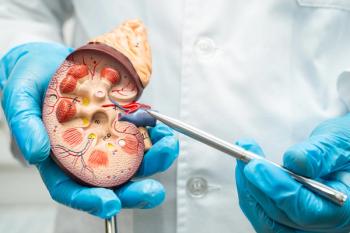
Experts: Treating Urinary Complications in a Patient With Multiple Sclerosis
Speakers in a presentation discuss a specific patient with MS who experienced urinary complications and the methods used to treat her.
During a presentation at the American Academy of Neurology 2024 Annual Meeting in Denver, Colorado, speakers Mario Habek, MD, PhD, an associate professor at the University of Zagreb and a neurologist at University Hospital Center Zagreb; and Tamara B. Kaplan, MD, assistant professor at Harvard Medical School and neurologist attending physician at Brigham and Women’s Hospital, highlighted a patient with multiple sclerosis (MS) who was having bladder complications as a result. They also walked through their approach to treating the patient and covered treatment options and methods of managing MS to improve the patient’s symptoms.
The speakers noted that the patient had bladder complications—particularly lower urinary tract symptoms (LUTS)—because of her MS. Patient symptoms included constant sensations of needing to urinate, urinating 10 times per day and 3 times per night, incontinence without an associated urge to void, and voided volumes (<50 mL), as well as other symptoms.
Habek noted that the first step when evaluating the patient’s urinary symptoms was a urinary dipstick because of a urinary infections' ability to mimic—and potentially worsen—symptoms of neurogenic bladder. The tests should be performed at the initial evaluation and then again during a clinically indicated follow-up with the patient, according to Habek. The dipstick test has a high specificity and sensitivity for detecting urinary pathology while excluding LUT infections.
Following the test—which came back normal for the patient—the patient completed a 3-day bladder diary, in which she recorded information at the initial evaluation and again at follow-up to provide an objective assessment of the bladder symptoms. Next, the patient’s post-void residual volume (PVR) was recorded, which can be completed via urinary catheterization (Habek noted that this isn’t ideal because it is invasive and is associated with risks), a portable dedicated bladder scanner, or a formal ultrasound examination.
“So, if we have [a] PVR higher than 100 mLs in people with MS, this is [an] indication for a referral to neurologists, because of the people who have increased PVR, the rest of the volume has an increased risk of upper respiratory tract damage. So, when we performed [this test] in our patient, [her PVR] was 250 mLs, [therefore,] this patient with MS has an increased risk of upper respiratory tract damage and we should follow the patient together with urologist,” said Habek during the presentation.
Finally, Habek said the patient underwent a renal function assessment, which was part of an initial evaluation and can be repeated in a follow-up if instructed. Additionally, renal function should be tested annually for those with stable bladder symptoms who are at risk for upper urinary tract infections (UTIs), according to Habek. After the assessments, the patient with MS was determined to have an overactive spinal (infrapontine-suprasacral) lesion.
When it comes to spinal lesions, Kaplan noted that approximately 92% of patients with MS in a 2015 study reported experiencing LUTS—both male and female patients—of which 30% never sought treatment despite the severity of their symptoms. According to the study, patients did not seek out treatment because they felt their symptoms were not severe enough to seek consultation, they were uncomfortable discussing symptoms with their providers, their providers did not ask, and patients did not believe that their providers could help.
There are a variety of treatment methods for neurogenic bladder that range from noninvasive to more invasive. Typically, patients are first advised to try lifestyle changes such as pelvic floor rehabilitation exercises; reducing caffeinated, carbonated, and alcoholic beverage intake; and smoking cessation, or to try pharmacologic therapies. Kaplan also explained how bladder training has proven to be an effective method for patients in her practice. More invasive methods include self-catheterization, electrical stimulation, botulinum toxin (Botox; Allergan, Inc.), and surgical interventions.
“I have patients that say when [they] have [the] urge [to urinate], [they feel like they] have to go so bad…and I say, ‘Well, how long has it before since the previous time you went to the bathroom?’ and [they tell me]…a couple of hours,” said Kaplan during the presentation. “So, rather than waiting for that urge to come, I start saying to patients, [as an example], maybe just for the next week, try going every hour, and this can be helpful when someone's having retention to have multiple attempts to void, or some of those having urgency to avoid those periods where the bladder is filled so much that that they can't hold it anymore. And then over time, we can increase the interval…try to void every hour and a half, and so on and so forth to train the bladder.”
When treating this patient, Kaplan noted that her PVR was 250 mL, she had a negative urinalysis, and her bladder diary recorded frequent voids with small volume, as well as intermittent urgency and hesitancy urinating. Additionally, she had reported taking oxybutynin (Ditropan; Janssen); however, she developed several UTIs while on the medication and was advised by her provider to discontinue the treatment. Additionally, Kaplan explained that antimuscarinic medications would not be a suitable treatment due to the patient’s voiding problems and increased PVR, and this drug would increase the risk of her retaining large volumes of urine, potentially leading to a UTI.
The patient initiated clean intermittent catheterization (CIC) to treat her voiding dysfunction. CIC significantly improved her quality of life and LUTS by decreasing her urinary frequency, reducing her urgency, and lessening her stress incontinence. Her CIC schedule, according to Kaplan, is once every 4 hours during the daytime and once before bedtime. Additionally, the patient received botulinum toxin injections. Since treatments initiation, the patient reported significant improvements in both urinary frequency and urgency with no further UTIs.
Kaplan ended the presentation by highlighting additional tools, particularly neuromodulation with posterior tibial nerve stimulation, which is more common internationally although it has been around in the US for a long time. She explained how she has utilized neuromodulation as well as her predictions why US providers don’t recommend this treatment for patients.
“[Neuromodulation] is something that's endorsed by the American and Canadian Urologic Associations, so why aren’t we doing this? I think probably a few reasons. Number 1, I think neurologists are just not really focused on this. There has to be a space for people to sit and do this if you're going to do it in your office, and then urologists are not really interested in this either, because…I [am unsure on] how this is reimbursed, but…patients can do this at home too, and they could even get it a [transcutaneous electrical nerve stimulation (TENS)] unit, and I've done this several times and showed [patients] the proper settings to do on a TENS unit at home. And so, it is something that we could easily recommend.”
Reference
Habek, M, Kaplan, T. Neuro-urology — Understanding and Managing Neurogenic Bladder Dysfunction: Cases of Neurogenic Bladder and Sexual Dysfunction — Assessment and Treatment in Multiple Sclerosis. Presented at: American Academy of Neurology 2024 Annual Meeting; Denver, Colorado. April 13-18, 2024.
Newsletter
Stay informed on drug updates, treatment guidelines, and pharmacy practice trends—subscribe to Pharmacy Times for weekly clinical insights.


















































































































































































































